
Small Group Coaching – Providing effective, individualised Tier 3 intervention for Reading in the K-6 classroom or Clinic
Details
Live online via Zoom | 5 participants Maximum
Lunchtime Option -> Tuesday 12 – 1 pm [AEST] | May 31 | June 7 | June 14 | June 21
Evening Option -> Tuesday 7:30 – 8:30pm [AEST] | May 31 | June 7 | June 14 | June 21
Content
Session 1 -> Science of Reading Research | Understanding Dyslexia & other co-occuring learning difficulties, disabilities & complex medical conditions
Session 2 -> Assessment | Tools to develop an individual student profile & progress monitoring
Session 3 -> Intervention | Understanding the toolbox of intervention options & matching intervention to student profile
Session 4 -> Providing effective classroom supports | Using Assistive technology tools to support student independence
Price
$ 300 plus GST [Total $330]
This coaching is appropriate for classroom teachers | learning support teachers or co-ordinators | tutors | literacy co-ordinators | speech pathologists

There are many options to assess a student’s reading and it is often a minefield to know where to start. Fortunately there are common skills that are the focus of assessment. and knowing your purpose for assessment helps you to determine which tools to use.
[Hint: click on the resources in the font that is both bold and italicised to be taken to find the resource]
Purpose 1 → Identification
Also known as Universal Screening. This is where assessment of the entire cohort of students is completed and the purpose is to identify those students at risk of not making adequate progress. The FREE Universal Screening tools have been designed in alignment with research in order to measure the skills that are known to be predictive of student reading success. In Australia the two most commonly used Universal Screening Assessments for K-6 are Acadience Reading and DIBELS 8th edition. In addition there has been a very good case made by Dr Tiffany Hogan for adding in a Universal Screening assessment of Oral Language and the current best available option to use alongside Acadience Reading or DIBELS 8th Edition is the CUBED Narrative Language Measure. You can learn more about these in a previous blog post I wrote found here.
For both Acadience Reading & DIBELS you can purchase access to the online data tracking tool for a cost of between US $1-1.50 per student. Online Training for DIBELS is organised by SpeldSA
If a student is assessed as being below benchmark level in the CUBED Narrative Language Measure I would refer for formal language assessment with a Speech Pathologist.
Purpose 2 → Progress Monitoring
The Universal Screening tools mentioned above, have the added advantage that they are also designed for progress monitoring with testing formats allowing for reassessment 3 times in a school year. This is extremely useful because at times, students will plateau and this approach allows for early identification of students requiring additional support.
There are a range of free and paid Progress Monitoring Assessment tools that align to specific Systematic Synthetic Phonics Programs, Decodable Readers and particular instructional scope and sequences. These include [but are not limited to]
Free & Paid
Phonic Books UK – Aligned to the scope and sequence of Sounds Write | Dandelion Readers | Phonic Books Catch Up Readers | The Drop In Series by Forward with Phonics
Diagnostic Assessment Cards | Dandelion Readers Assessment
Little Learners Love Literacy – Reading Assessment [LLARS]
MultiLit Suite of Assessments – Access to Schools who have completed training
Decodable Readers Australia – The Sparkle Kit
Sounds Write Assessment – Access to those who have completed training
SPELDNSW – Literacy Hub – Aligned to new NSW K-2 English Syllabus
Purpose 3 → Intervention
For a student who is identified by Universal Screening Assessment as requiring intervention, the next step would be to further assess phonological awareness and rapid automatic naming skills. As a teacher, I typically use criterion or curriculum based assessment tools as they are easy to access and administer. It also means that I’m not going to impact the retest validity of a normed assessment that might be used for diagnostic purposes
Free Curriculum Based Assessment Tools
Phonological Awareness include
Little Learners Love Literacy – Phonological Awareness Assessment [TOPALL]
Phonological Awareness Screening Test [PAST]
Heggerty’s Phonemic Awareness – Australian Assessments
A combined assessment of Phonological Awareness and Rapid Automatic Naming
Read 3 – CHIPS – Early Literacy Screener
I would then also use the Progress Monitoring Assessment tools to customise intervention and monitor progress in a response to intervention model.
Free
Phonic Books UK – Aligned to the scope and sequence of Sounds Write | Dandelion Readers | Phonic Books Catch Up Readers | The Drop In Series by Forward with Phonics
Diagnostic Assessment Cards | Dandelion Readers Assessment
Little Learners Love Literacy – Reading Assessment [LLARS]
MultiLit Suite of Assessments – Access to Schools who have completed training
Decodable Readers Australia – The Sparkle Kit
Sounds Write Assessment – Access to those who have completed training
SPELDNSW – Literacy Hub – Aligned to new NSW K-2 English Syllabus
Purpose 4 → Diagnosis
Standardised or Norm Referenced Assessments are typically used for formal profiling of a student’s reading ability and diagnosis of Specific Learning Disorder – Reading [also known as Dyslexia]. Dyslexia is known to be associated with difficulties with Phonology, one of the components of language skills. Therefore it is commonly referred to as a language based learning difficulty. Within the sub category of Phonology, a student with Dyslexia can have difficulties with Rapid Automatic Naming [RAN] which typically presents as oral reading fluency difficulties, Phonological Awareness Difficulties or both. Dyslexia typically presents with difficulties with word decoding and can be a developmental difficulty or acquired difficulty.
Diagnosis of Dyslexia in Australia is typically made by a registered psychologist and the DSMV guidelines indicate that the diagnosis is only made after a minimum of 6 months evidence based intervention.
Standardised Assessments include
YARC – the York Assessment of Reading Comprehension [This replaced the Neale]
Woodcock Reading Mastery Test – 3rd Edition
Test of Word Reading Efficacy 2 [TOWRE-2] – This is an assessment of fluency at word level
Comprehensive Test of Phonological Processing – 2 [CTOPP-2]
Motif Assessments – Here you will also find the Australian Norms for the TOWRE-2
Test of Integrated Language & Literacy Skills [TILLS]
If you’d like more information or professional support regarding implementation of a whole school assessment framework or use of assessments for intervention or diagnostic purposes get in touch and arrange customised coaching, join a small group coaching group or join one of my courses.
Supporting Learning Difficulties in Mathematics / Dyscalculia
Many would ask why I would be equally as interested in supporting learning difficulties in Mathematics as I am in supporting learning difficulties in Literacy. Interestingly, Jane Emerson who wrote the Dyscalculia Solution and The Dyscalculia Assessment is a Speech Pathologist with a special interest in Mathematics Learning Difficulties from the UK.
As a part of my upcoming presentation for the Dyslexia SPELD Conference which goes live on Easter Tuesday, I’ve been reading the recently published book by Dr Valerie Muter, titled Understanding and Supporting Children with Literacy Difficulties: An Evidence-Based Guide for Practitioners. Dr Muter has spent 15 years working as a consultant neuropsychologist at Great Ormond St Hospital for Children in the UK and has also partnered in much research with Professor Margaret Snowing. If you work with Tier 3 students in a clinic or school based intervention setting this is a must read book.
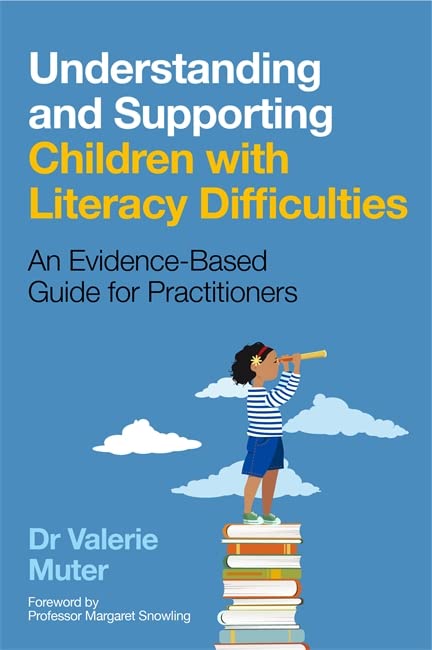
But I digress, I have recently shared my near point reference for supporting students who struggle with recall of Multiplication and Division Facts. It is also extremely useful for supporting understanding of Division with remainder, multiples and factors. The image below comes from Dr Muter’s book, p. 97 [see above]
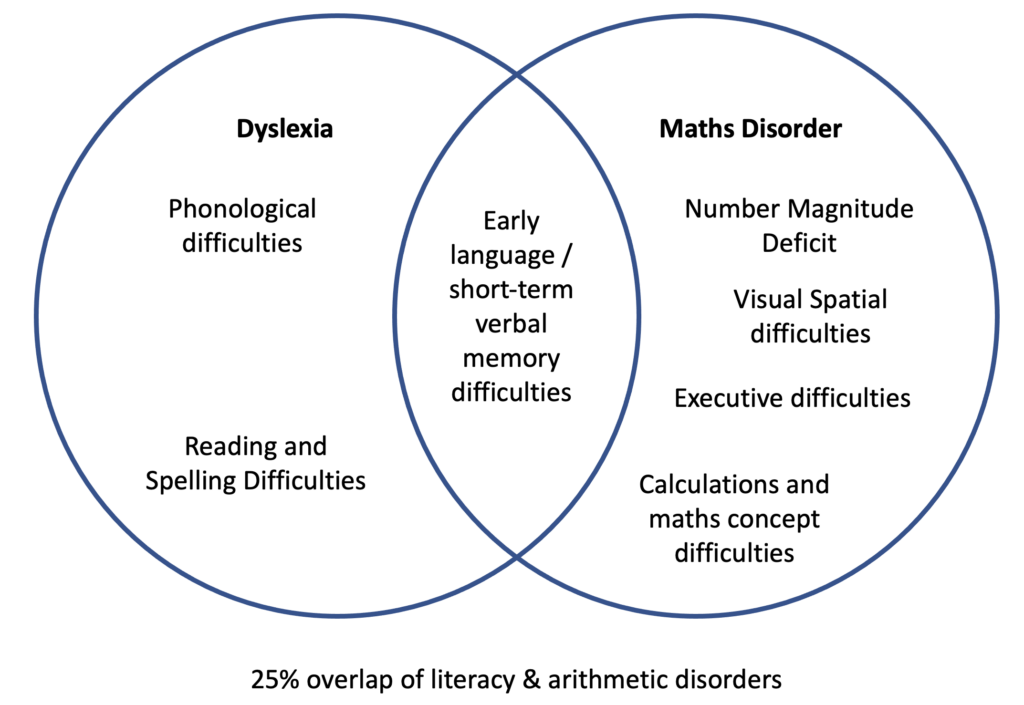
For our students with both Dyslexia and Maths Disorder [also known as Dyscalculia] recall of Mathematical Fact knowledge, especially Multiplication and Division facts is going to be a challenge. Too often we allow these difficulties to prevent a student from progressing to learning more advanced mathematical computation skills. It is increasingly common for schools to be using online mathematics programs to ‘teach’ mathematics in lieu of a specialist mathematics teacher and unfortunately a ‘mastery of maths facts’ requirement means that for some students where their Math Disorder is a lifelong disability they aren’t given the opportunity to progress in their development of mathematical computational skills because they don’t have the required basic facts retrieval fluency so the ‘online program’ creates an artificial ‘ceiling effect’.
Another concept to consider which I was reminded of when I completed Multisensory Math 1 with Marilyn Zecher, is that recall of numbers by rote is actually a word retrieval or language based naming task rather than a mathematical computational task. Therefore, if a student has difficulties with language, a ‘skill and drill’ approach isn’t going to assist them to progress.
Back in 2002, when I completed my Masters in Special Education, I completed my final project on the impact of Language Impairment on the development of Mathematical Skills. Back then research indicated that best practice was the Concrete – Representational / Semi-Concrete – Abstract instruction sequence. My near point reference that you can access below supports students to move beyond the concrete stage of Multiplication and Division Facts to provide them with a Representational or Semi Concrete tool to support their ability to progress to learning more advanced mathematical computational skills. To update it, I have also provided it formatted for use on See Saw and I will shortly add a Google Slides Version.
Once consideration for assessment: Do you structure your assessment tasks so that you can identify whether the student has difficulty with the process of fact knowledge [ie. retrieval] or mathematical computational skills. To do this with my struggling upper primary students, I would regularly set assessment tasks that included two parts – eg. 1. Map the 6 times tables on the hundreds chart provided 2. Use this information to complete multiplication and division tasks or answer questions about factors, multiples and complete tasks involving division with remainder. What I observed was that students who would typically ‘melt’ and task avoid would engage and across the school year they would shift to working without the near point reference tool as their self confidence and accuracy of recall improved. Furthermore, students could see their progress and knew that they weren’t ‘hopeless at all mathematics’ but rather they struggled to recall certain table facts.
You can download the free resource here and over time I will add to the collection
Universal Screening for Literacy
Is there a gap in your K-3 data?
Universal Screening is a battery of assessments given to all students in order to develop a profile of strengths and weaknesses. It can then be re administered either each term or mid year and end of year in order to monitor progress. This approach fits within a response to intervention model of student support. There are many times that a student will appear to be tracking at an appropriate rate but then begin to plateau and without ongoing progress monitoring that builds on the previous data these students can sit below the radar.
The good news for schools is that there is an increasing range of Universal Screening options that can be accessed for FREE
In a K-6 context your universal screening assessment would be capturing data on the following information [Acadience Reading [formerly DIBELS Next] | DIBELS 8]
Phonemic Awareness
- First Sound Fluency [Acadience Only] | Phoneme Segmentation Fluency
Alphabetic Principle & Basic Phonics
- Nonsense Word Fluency – Correct Letter Sounds | Whole Words Read
Advanced Phonics & Word Attack Skills
- Oral Reading Fluency – Accuracy
Accurate & Fluency Reading of Connected Text
- Oral Reading Fluency – Correct Words per Minute | Accuracy
Reading Comprehension
- Maze | Oral Reading Fluency – Correct Words per minute + Retell Total [Grade 3 – 6]
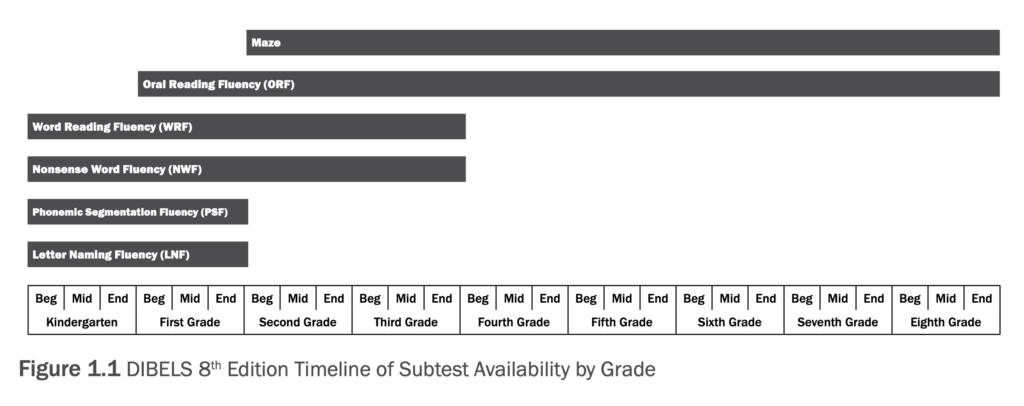
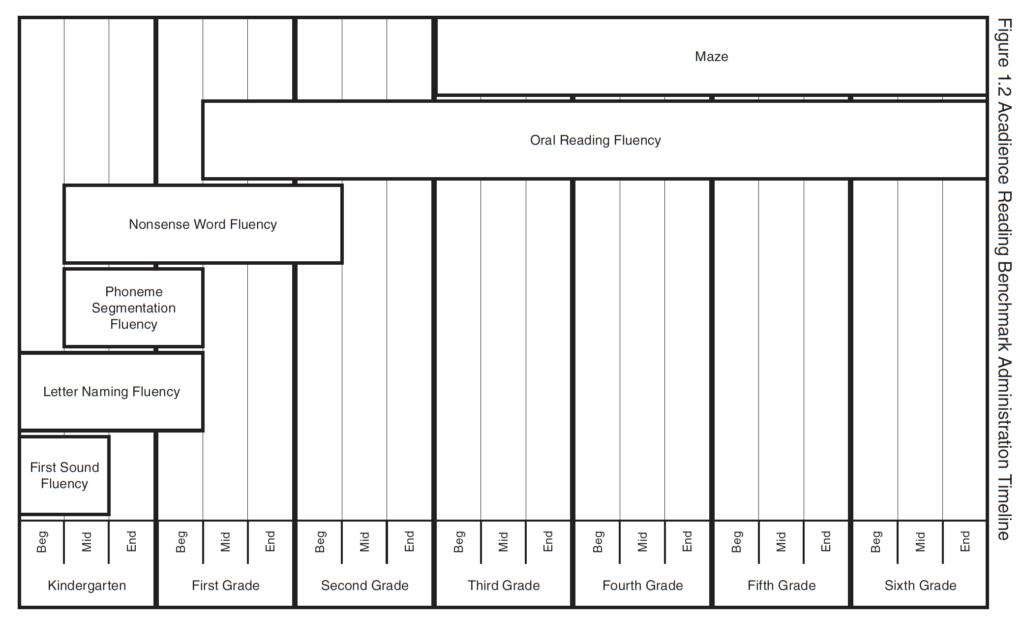
Administration of these assessments means that you are tracking progress along the Word Decoding Component of Scarborough’s Reading Rope but not comprehensively screening nor progress monitoring along the Language Comprehension Component until students are in Year 3. Given that the new NSW English Syllabus K-2 [2021] includes new outcomes for Oral Language and Vocabulary, and that oral language begins to develop at birth and continues to develop into late adolescence | young adulthood, it would make sense to add a universal screening tool for Oral Language that could be used for K-3.
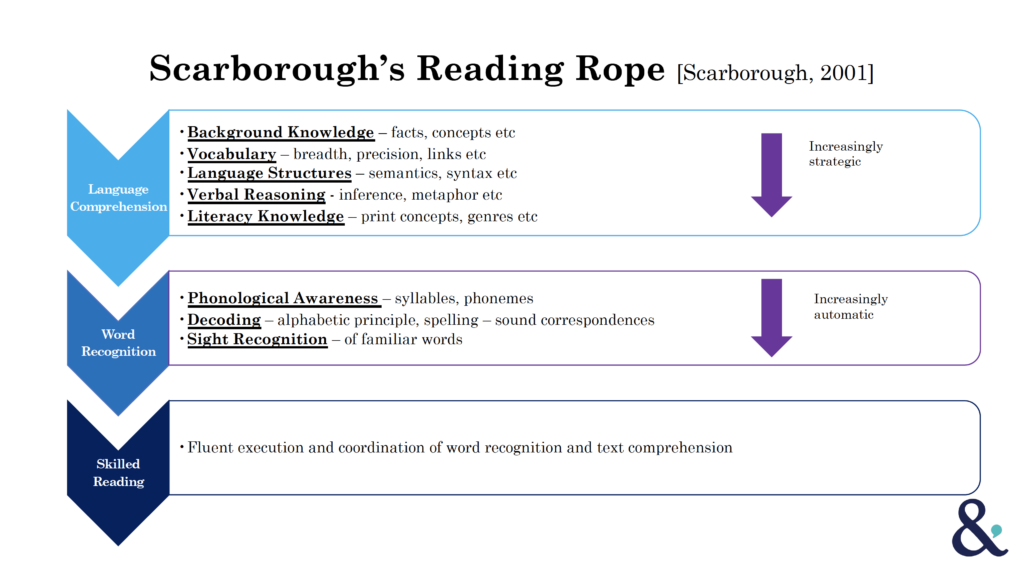
The best option available for Universal Screening within a school setting is the CUBED Narrative Language Measures. If your universal screening tool for reading can be used K-6 [ie. Acadience or DIBELS] you could easily add the CUBED Narrative Language Measure. This tool aligns very nicely to the new Oral Language & Vocabulary Outcomes in the syllabus & also aligns to the Story Champs Language Intervention Curriculum, a useful small group intervention option that could be easily implemented in a school setting.
For K-3 the NLM Listening [a universal screening battery of Oral Language] measures
Listening Comprehension
- measured through story retells as well as questions about the story
Expressive Language
- Using the optional personal generation section, expressive language can be elicited, transcribed and analysed
Inferential Word Learning
- Definitional vocabulary questions reflect students’ ability to determine the meaning of words through context
In summary, because listening and reading comprehension are the same construct, the NLM Listening measures reading comprehension before students can decode!
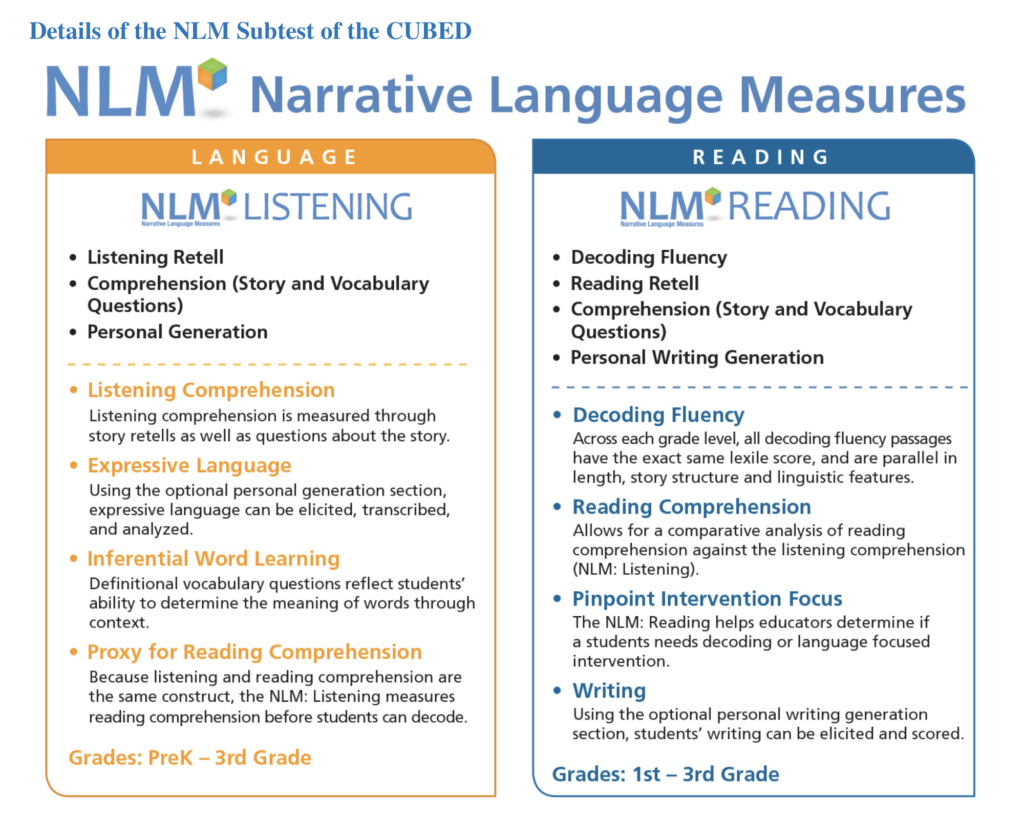
If you’d like to do a deep dive into understanding and implementing the new Oral Language Outcomes in the new NSW English Syllabus, join my mailing list and I’ll be in touch with course dates for later in Term 1.
You can also join my Facebook Group Language and Learning: Training & Support where you can find a range of resources and a platform to ask questions and network.
Should you wish to explore customised courses or coaching options for your School Leadership Team, Teaching or Aid Staff or your Clinical Team please reach out via my website to discuss your needs.
I’m also super excited to share my FREE progress monitoring spreadsheet for tracking student progress against the new Oral Language and Communication Outcomes for K-2. The tool provides a whole class tracking resource and an individual student profile template which is customised to both the Early Stage 1 and Stage 1 Outcomes of the new NSW K-2 English Syllabus. You can download your copy below
K - 2
- PLD resources
- Home Learning Resources from PLD
- Language for Thinking
- Language for Behaviour and Emotions
- Black Sheep Press Resources (Free Sample Downloads)
- Speaking and Listening through Narrative
- Read it Again – Foundation Q (Australian Curriculum Aligned)
- Language in the Class
- Book share time
- Let’s Know
- Riley Callie Resources – Yarning Cards
- Riley Callie Resources – Aboriginal Story Dice
3 - 6
- Language for Behaviour and Emotions
- Black Sheep Press Resources (Free Sample Downloads)
- From Oral to Written Narrative
Assessment, Intervention & Research
- Games & Tools – Toy Theater
- Language for Thinking
- Language for Behaviour and Emotions
- Cubed Narrative Language Assessment
- Language and Literacy in Young People
- Universally Speaking 0-5 | 5-11 (including checklist) & 11 – 18
- Oral Language Grammar Scope and Sequence
- Guidelines for teachers to elicit detailed and accurate narrative accounts from children
- Oral Language Competence: How it Relates to Classroom Behaviour
K - 2
- Concept Cat – Word Aware (Free Trial)
- Pre Teaching Vocabulary
- Florida Center for Reading Research – Student Center Activities
- Black Sheep Press Resources (Free Sample Downloads)
- Language in the Class
- Book Share Time
- The Text Project – Vocabulary Instruction
- Hyde Park Tier 2 Vocabulary Lists
- Nifty Word
- The Idioms
3 - 6
- Lift Lessons – Word Aware (Free Trial)
- Morphology Resources
- Florida Center for Reading Research – Student Center Activities
- Black Sheep Press Resources (Free Sample Downloads)
- Language in the Class
- Word Hippo
- Visual Thesaurus
- thesaurus.com
- The Text Project – Vocabulary Instruction
- Hyde Park Tier 2 Vocabulary Lists
- Nifty Word
- The Idioms
Assessment and Intervention
K - 2
- SPELD SA – Decodable Readers
- University of Florida – Virtual Teaching Hub
- University of Florida – Phonological Awareness Activities
- The Reading League – Reading Buddies
- Sounds Write – Free Initial Code Readers
- Sounds Write – Free Extended Code Readers
- Sounds Write – Teacher your child to Read & Write
- Really Great Reading
- Phonics for Special Education Needs
- DSF
- SPELDNSW
- Heggerty’s Phonemic Awareness
- Phonic Books UK – Free Teaching Resources
- Word Wall (Spelfabet)
- Spelfabet Spelling Lists [by grapheme|phoneme|morpheme]
- Lifelong Literacy (Lyn Stone)
Jim Jam Gang – Free, live spelling lessons in pyjamas: - PhOrMeS
- PLD resources – Home Learning Resources from PLD
- Florida Center for Reading Research – Student Center Activities
- Language in the Class
- Open Source Phonics
3 - 6
- SPELD SA – Intensive Reading Program
- University of Florida – Virtual Teaching Hub
- Really Great Reading
- Phonics for Special Education Needs
- DSF
- SPELDNSW
- Phonic Books UK
Free Teaching Resources from Phonic books Uk - Word Wall (Spelfabet)
- Spelfabet Spelling Lists [by grapheme|phoneme|morpheme]
- Lifelong Literacy (Lyn Stone)
Jim Jam Gang – Free, live spelling lessons in pyjamas: - PhOrMeS
- PLD resources
Home Learning Resources from PLD - Morphology Resources
- Florida Center for Reading Research – Student Center Activities
- Open Source Phonics
Secondary School
- SPELD SA – Intensive Reading Program
- Really Great Reading
- All about Adolescent Literacy (AdLit}
- DSF
- SPELDNSW
- Spelfabet Spelling Lists [by grapheme|phoneme|morpheme]
- Phonic Books UK
Free Teaching Resources from Phonic books Uk - Lifelong Literacy (Lyn Stone)
Jim Jam Gang – Free, live spelling lessons in pyjamas: - PhOrMeS
- PLD resources
Home Learning Resources from PLD - Morphology Resources
- Open Source Phonics
Assessment and Intervention
- SPELDNSW
- DSF
- Motif
- PLD Whole School Phonic Placement Test
- Phonic Books UK: Diagnostic Assessment Cards
- Little Learners Love Literacy Assessments [LLARS | ToPALL]
- Read3 CHIPS: Early Literacy Screener
- DIBELS 8th Edition [Universal Screener]
- Acadience Reading [Universal Screener]
- Teaching Phoneme Awareness in 2022: A Guide for Educators
Assessment and Intervention
3 - 6
- Dr Paul Swan Interactive Materials
- Cool Math
- Math Curious
- Didax Virtual Manipulatives
- Love Maths
- More Virtual Manipulatives
Virtual Manipulatives - Corbett Maths
- Pirate Math Equation Quest
- Numeracy Ninjas
- Maths Snack Videos
Secondary School


